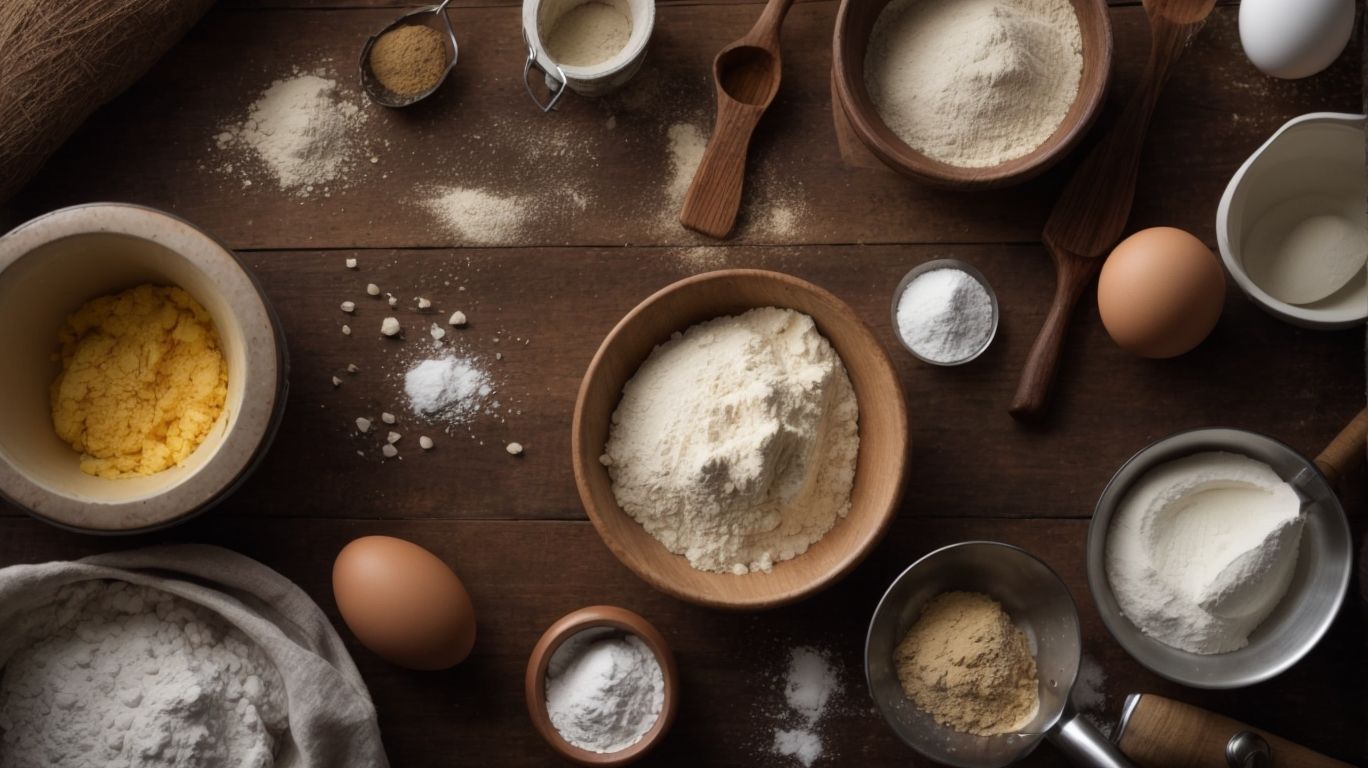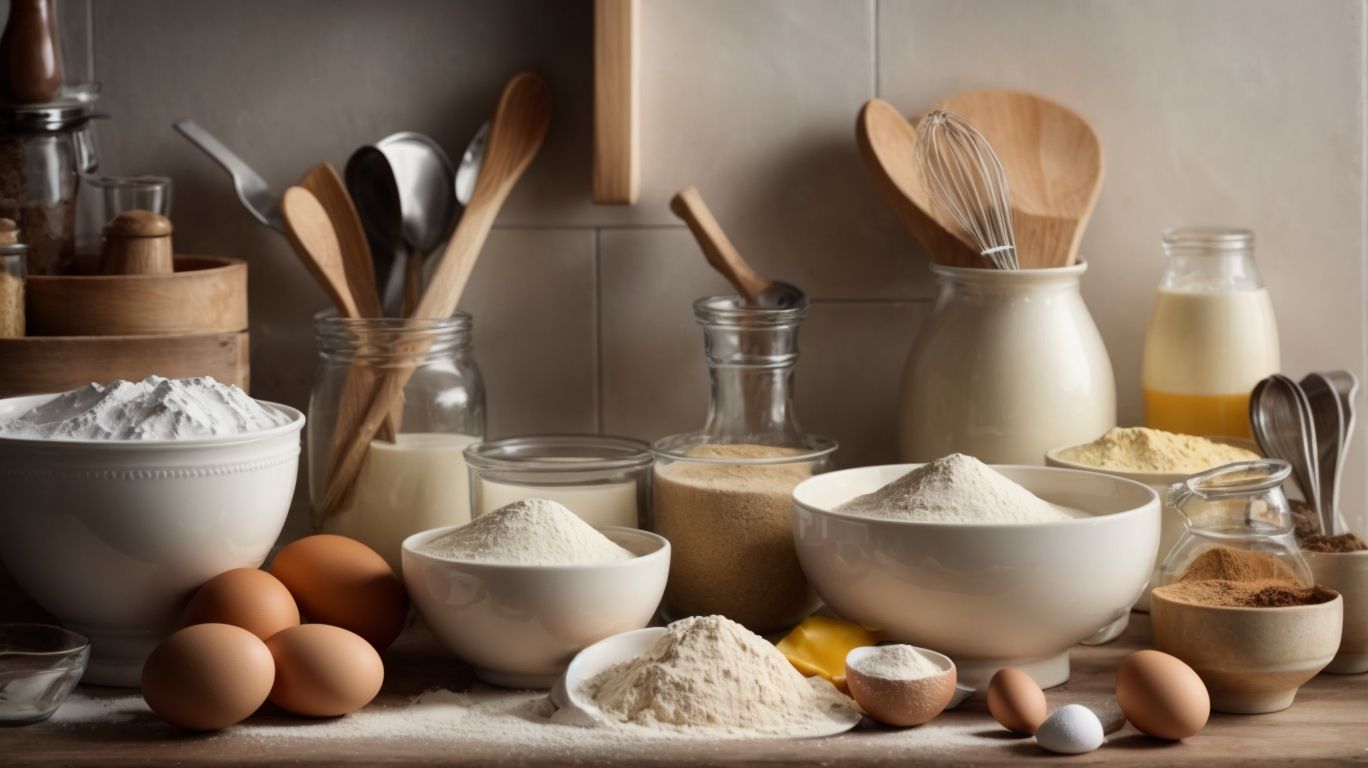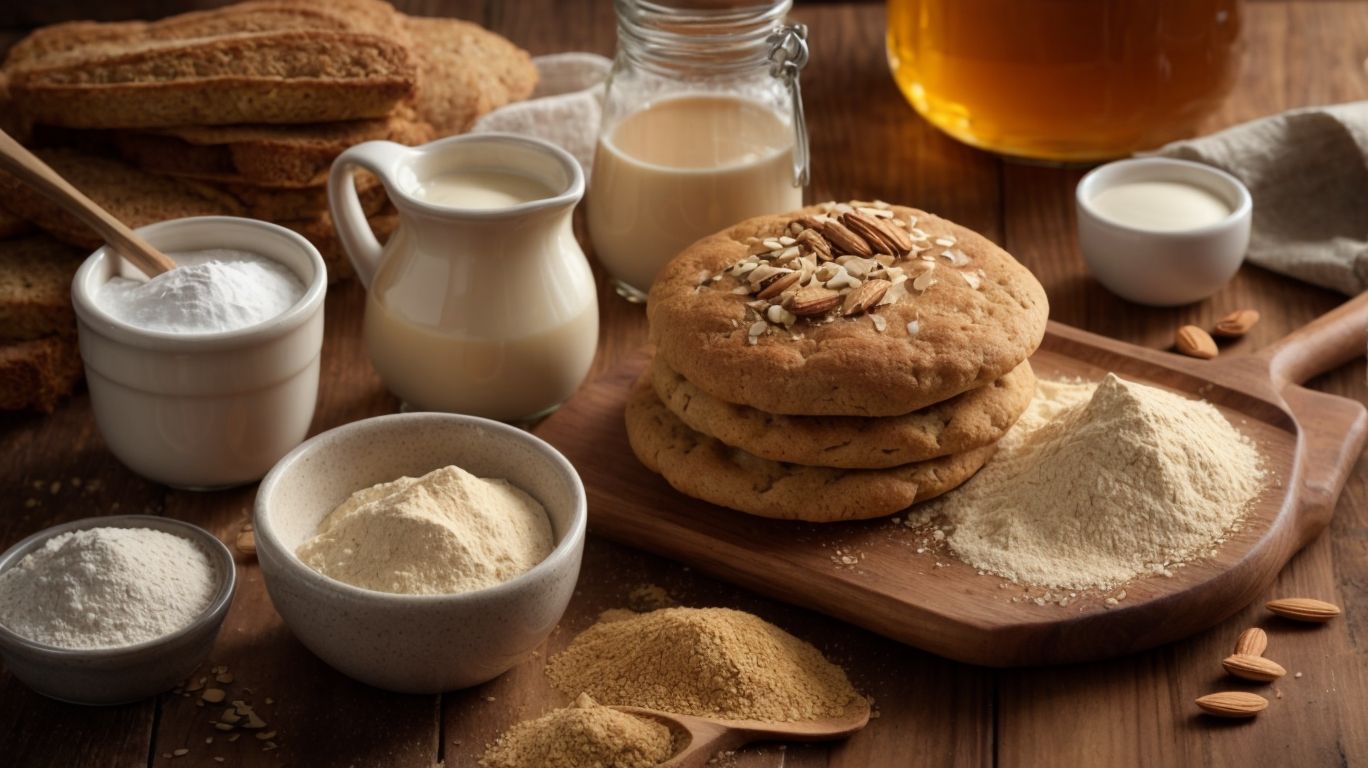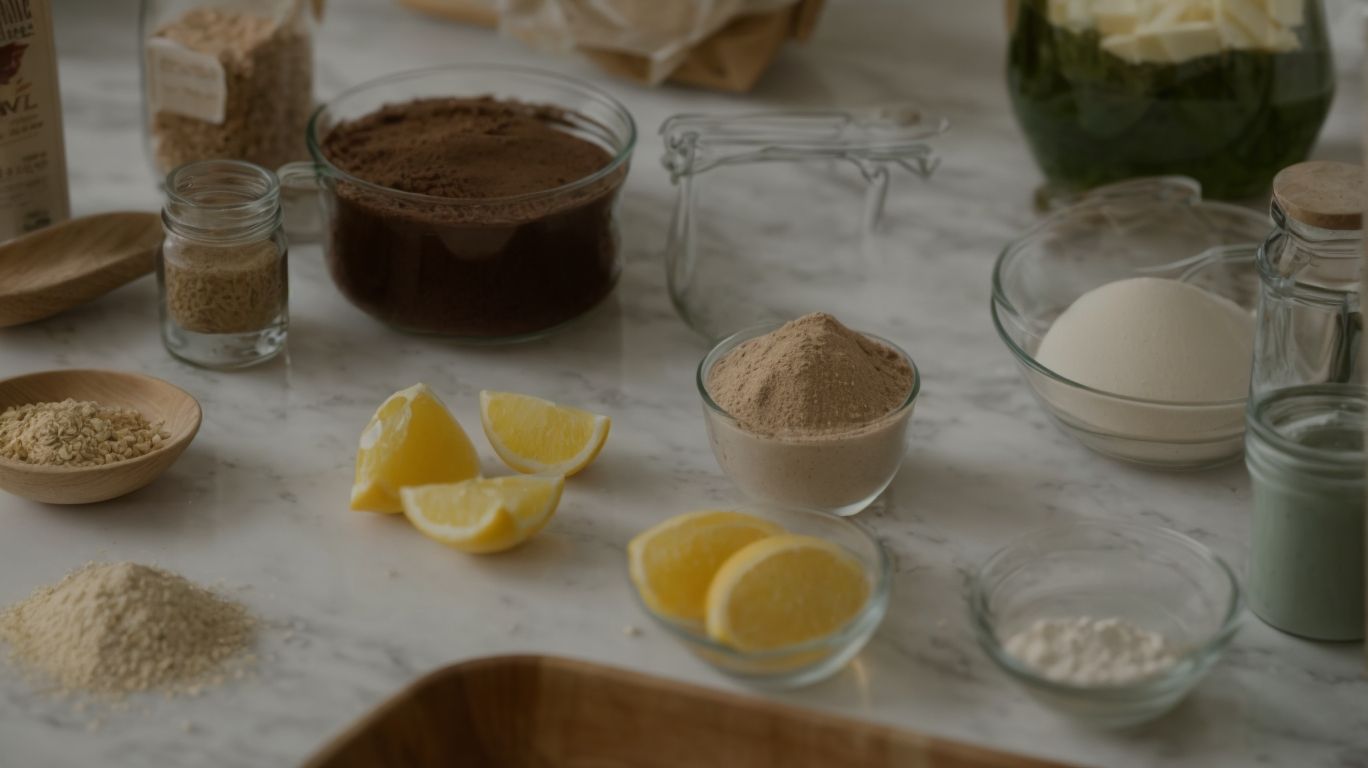How to Bake Things?
Looking to enhance your baking skills? Whether you’re a beginner or experienced baker, understanding the essential tools and basic ingredients required for baking is essential.
From bread to cake to pie baking, there are various baking techniques to explore.
In this detailed guide, we’ll take you through the entire process, from preparing ingredients to cooling and decorating your delicious creations.
We’ll also provide baking tips, such as how to measure ingredients accurately and avoid common mistakes. For those interested in healthier alternatives, we’ll explore gluten-free, sugar-free, and vegan baking options.
Prepare to improve your baking abilities with our comprehensive guide.
Key Takeaways:
What is Needed for Baking?

Credits: Poormet.Com – Randy Flores
To start baking delicious treats like chocolate chip cookies, cake, muffins, and quick breads, you will need essential baking tools and basic ingredients.
Among the essential baking tools, you will need measuring cups and spoons for precise ingredient quantities, mixing bowls for mixing and combining ingredients, a whisk for blending, and baking pans to shape your creations.
- Basic ingredients such as flour, sugar, butter, eggs, and leavening agents like baking powder and baking soda are fundamental for most baking recipes.
- Popular recipes like chocolate chip cookies require chocolate chips, vanilla extract, and brown sugar, while cakes may call for cocoa powder, baking soda, and buttermilk. Muffins often include fruits, nuts, or spices for added flavor and texture.
Essential Baking Tools
Having the right baking tools is crucial for successful baking endeavors. Some essential tools include mixing bowls, measuring cups, an oven, spatula, whisk, baking sheet, and more.
Mixing bowls are versatile and come in various sizes, perfect for combining ingredients. Measuring cups ensure accuracy in baking by precisely measuring liquids and dry ingredients.
An oven is the heart of the baking process where the magic happens, baking treats to perfection. A spatula aids in folding, scraping, and smoothing batters. A whisk is essential for incorporating air into mixtures for light and fluffy results.
Basic Ingredients
Basic ingredients such as flour, sugar, eggs, and butter form the foundation of most baking recipes. Other common ingredients include baking powder, salt, vanilla extract, chocolate chips, fruits like bananas and apples, and nut butters.
Flour acts as the main structure builder, providing the necessary bulk and texture to baked goods. Sugar not only adds sweetness but also helps with browning and moisture retention. Eggs are crucial for binding and leavening, contributing to the overall structure and volume of the baked item. Butter imparts flavor, richness, and tenderness, making the end product more palatable.
Baking powder is a key leavening agent that helps baked goods rise, while salt enhances the flavors and balances sweetness. Vanilla extract adds depth and aroma, elevating the taste of desserts. Ingredients like chocolate chips, fruits, and nut butters offer additional flavors, textures, and nutritional value, allowing for endless creative possibilities in baking.
Types of Baking
Baking offers a diverse range of options, including bread baking, cake baking, and pie baking, each presenting unique challenges and opportunities for culinary creativity.
Regarding bread baking, the focus is on achieving the perfect balance of a crispy crust and a soft interior. Popular bread recipes like sourdough or French baguette challenge bakers to master the art of fermentation and dough handling.
In contrast, cake baking involves delicate measurements and precise mixing techniques to achieve moist and fluffy cakes. From classic chocolate cakes to intricate layered creations, there is a cake recipe for every occasion, catering to diverse taste preferences.
On the other hand, pie baking emphasizes the interplay between a buttery crust and flavorful fillings. Whether it’s a traditional apple pie or a savory quiche, pie recipes encourage experimentation with various fruits, custards, or meats to create delectable treats.
Bread Baking
Bread baking is a rewarding culinary pursuit that includes making various types of bread like no knead bread, sourdough bread, French baguette, sandwich bread, and zucchini bread, each offering a distinct flavor and texture.
Regarding bread making, achieving the perfect texture and flavor is a delightful journey. For no knead bread, the key is in the long fermentation process that enhances the flavors.
Sourdough bread, on the other hand, requires a starter made from flour and water, allowing for a tangy taste and a chewy texture.
French baguettes are known for their crispy crust and soft interior, achieved through proper shaping techniques and precise baking temperatures. Creating sandwich bread involves careful proofing to ensure a light and airy structure that is ideal for sandwiches and toasts.
On the sweeter side, zucchini bread incorporates grated zucchini for moistness, along with warm spices like cinnamon and nutmeg that bring out the vegetable’s natural sweetness.
Cake Baking
Cake baking allows for indulging in sweet delights such as chocolate cake, coffee cake muffins, angel food cupcakes, cinnamon sheet cake, coconut cookies, and cardamom cream-filled bundt cake, each offering a unique taste experience.
Regarding baking techniques, perfecting the art of creaming butter and sugar is essential for achieving a moist and tender crumb in cakes.
- For a lighter texture, incorporating whipped egg whites into the batter for chiffon cakes is a game-changer, resulting in a fluffy, airy dessert.
- Regarding frosting options, the timeless allure of cream cheese frosting complements red velvet cakes exquisitely, while a glossy ganache glaze enhances the richness of decadent chocolate cakes.
- To elevate your cake decorations, try experimenting with intricate piping techniques to create beautiful floral designs or opt for a minimalistic approach with elegant dustings of powdered sugar or cocoa.
Pie Baking
Pie baking introduces a delightful array of sweet and savory creations, from blueberry pie bars and strawberry rhubarb pie to neapolitan pie, fig tarte tatin, and blackberry cobbler, each offering a burst of flavors.
There is something truly special about the process of crafting the perfect pie, starting with the foundation – the crust. A flaky crust is essential, achieved by combining simple ingredients like flour, butter, and a touch of salt.
For fillings, options abound – whether you opt for a classic apple pie with cinnamon and nutmeg or a decadent chocolate silk pie, the key lies in balancing sweetness and acidity. And let’s not forget the decorative touches – lattice tops, crumb toppings, or intricate cutouts – a well-executed design can elevate any pie to a work of art.
Step-by-Step Guide to Baking
Mastering the art of baking involves following a step-by-step guide that includes preparing the ingredients, mixing them, baking the goods to perfection, and finally, cooling and decorating the finished treats.
Once you have gathered all the necessary ingredients, it’s time to start the baking process. Begin by preheating your oven to the specified temperature mentioned in the recipe to ensure even baking. While the oven is preheating, prepare the baking pans by greasing them lightly or lining them with parchment paper to prevent sticking. This step is crucial for easy removal of your baked treats once they are ready.
Preparing the Ingredients
The first crucial step in baking is preparing the ingredients meticulously, which involves measuring them accurately, selecting high-quality ingredients, and analyzing the recipe requirements for a successful outcome.
Accurate measuring is essential to ensure the right balance of flavors and textures in your baked goods. Using a digital kitchen scale can provide precise measurements, especially for ingredients like flour and sugar.
Choosing high-quality ingredients, such as organic flour or pure vanilla extract, can elevate the taste and overall quality of your final product. Fresh ingredients often yield superior results compared to lower-grade alternatives.
Recipe analysis is crucial for understanding the interaction of ingredients and the step-by-step process. Make sure to read through the recipe thoroughly before starting and consider any potential ingredient substitutions or variations.
Mixing the Ingredients
Mixing the ingredients skillfully is a crucial phase in baking, where batter preparation, dough kneading, and mastering mixing techniques play a pivotal role in the texture and flavor of the final baked goods.
One key element to successful mixing is ensuring that ingredients are properly measured and at the right temperature to achieve the desired results.
Whether you are using the creaming method, folding technique, or the all-in-one method, each technique requires attention to detail and precision.
Investing in quality mixing equipment like stand mixers, hand mixers, and spatulas can make the entire mixing process more efficient and effective.
Remember, overmixing can lead to tough textures, so it’s important to know when to stop mixing to maintain the perfect consistency in your creations.
Baking the Goods
The baking process involves setting the right oven temperature, determining the appropriate baking time, employing specific techniques, and identifying visual and olfactory indicators of doneness for perfectly baked treats.
A crucial aspect of baking is ensuring that the oven temperature is accurately calibrated to the recipe’s requirements. Temperature adjustments may be needed based on your oven’s performance to achieve consistent results.
Each recipe dictates a specific baking time, and understanding variations based on different types of baked goods is vital. To ensure even baking, rotating the pans halfway through the baking time is a common technique. Look for golden-brown hues on the outer edges of your treats to indicate they are ready. The scent of baked goods permeating your kitchen is another telltale sign of their doneness.
Cooling and Decorating
After baking, proper cooling and decorating techniques add the final touches to your treats. From frosting and glazing to creative toppings, the cooling and decorating phase enhances the visual appeal and taste of your baked creations.
Regarding cooling, allowing your baked goods to cool completely on a wire rack helps prevent sogginess by allowing air to circulate around them. Ensuring your treats are cooled properly before decorating is crucial for optimal results. You can speed up the cooling process by placing them in the fridge for a bit.
Once cooled, the fun part begins – decorating! Frosting your goodies in various ways, from simple swirls to intricate designs, can elevate their aesthetic appeal. Experimenting with different piping tips and techniques can make all the difference in the presentation.
Baking Tips and Tricks

Credits: Poormet.Com – Kevin Wright
Enhance your baking skills with valuable tips and tricks that cover how to measure ingredients correctly, avoid common baking mistakes, and store your freshly baked goods for freshness and longevity.
When measuring ingredients, remember to spoon and level flour, cocoa, and powdered sugar to ensure accuracy. Using a kitchen scale for precise measurements can greatly enhance the consistency of your baked goods.
To prevent common baking mishaps, always preheat your oven to the correct temperature and invest in quality bakeware. After baking, let your creations cool completely before storing them in airtight containers at room temperature or freezing them for future enjoyment. These simple yet effective tips will elevate your baking game to new heights!
How to Measure Ingredients Correctly?
Precise measurement of ingredients is essential in baking for consistent results. Utilize tools like measuring cups, a kitchen scale, and understand the difference between volume and weight measurements for accurate baking.
When measuring ingredients for baking, accuracy is key as even a small difference can greatly affect the final outcome of your baked goods. Using measuring cups for volume measurements and a kitchen scale for weight measurements ensures that you are following the recipe precisely. Volume measurements are ideal for ingredients like flour and water, while weight measurements are more accurate for items like butter and nuts.
By mastering the art of accurate ingredient measurement, you can achieve perfect texture, taste, and consistency in your baked creations.
How to Avoid Common Baking Mistakes?
Learn how to steer clear of common baking pitfalls by understanding recipe deviations, handling ingredient substitutions, and calibrating your oven for precise temperature control, ensuring successful baking outcomes every time.
One of the most crucial steps in avoiding baking mishaps is to accurately measure the ingredients specified in the recipe. Small deviations in quantities can lead to significant changes in the final product’s texture and taste. Always use measuring cups and spoons for dry ingredients and a digital scale for precise measuring of liquids and flour. Remember that ingredients like baking powder, baking soda, and yeast should be fresh to ensure proper leavening.
When substituting ingredients, especially in baking, it’s essential to understand their individual purposes and properties. For example, swapping out butter for oil can affect the texture and moisture of the baked goods. Similarly, replacing sugar with a natural sweetener may alter the sweetness and browning of the final product. Be mindful of the role each ingredient plays in the recipe to make informed substitutions.
How to Store Baked Goods?
Preserve the freshness and flavor of your baked creations by employing proper storage techniques. Utilize airtight containers, appropriate refrigeration, and freezing methods to extend the shelf life of your treats.
Regarding selecting storage containers for your baked goods, opt for containers with a good seal to keep air out and preserve moisture levels. Glass or plastic containers with tight-fitting lids work well for most baked treats, preventing them from drying out or becoming stale.
- For refrigeration, place delicate items like cakes and pastries in sealed containers or wrap them with plastic wrap to prevent absorption of other odors.
- When freezing, ensure that your baked goods are completely cooled before storing them in freezer-safe bags or containers to maintain freshness and avoid freezer burn.
Remember, proper storage is key to enjoying your homemade delights for longer periods without compromising on taste or quality.
Healthier Baking Alternatives

Credits: Poormet.Com – Peter Thomas
Explore healthier baking options by diving into gluten-free, sugar-free, and vegan baking alternatives that cater to dietary restrictions and preferences, offering nutritious and delicious options for all.
Gluten-free baking swaps traditional flour for alternatives like almond flour, coconut flour, or gluten-free oats, making treats easier on the digestion and suitable for those with celiac disease or gluten sensitivities.
Vegan baking eschews eggs and dairy, using flaxseed eggs, applesauce, or plant-based milk instead, creating lighter desserts with a lower environmental impact.
Regarding sugar-free baking, look for natural sweeteners like monk fruit, stevia, or dates to cut down on refined sugars while still satisfying your sweet tooth. These alternatives not only reduce the calorie load but also provide additional nutrients that you won’t find in traditional sugars.
Gluten-free Baking
Gluten-free baking caters to individuals with gluten sensitivities such as celiac disease, utilizing alternative flours, xanthan gum as a binding agent, and creating a variety of delicious gluten-free desserts for everyone to enjoy.
When shifting to a gluten-free approach, bakers often explore a range of flours like almond flour, coconut flour, and teff flour, each imparting unique flavors and textures to baked goods.
- In the absence of gluten, xanthan gum steps in to mimic its binding properties, ensuring the desired structure and elasticity in the final product.
- Commonly used ingredients such as flaxseed meal, psyllium husk, or gelatin serve as effective substitutes for gluten, enhancing the overall composition of gluten-free treats.
Sugar-free Baking
Sugar-free baking appeals to those seeking healthier dessert options by using natural sweeteners, sugar alternatives, and crafting diabetic-friendly treats that are both delicious and nutritious.
Regarding sugar-free baking, the options are endless. From using stevia and monk fruit to erythritol and xylitol, there are various natural sweeteners that can add sweetness to treats without the added sugar. These alternatives not only provide a guilt-free indulgence but also cater to individuals with dietary restrictions like diabetes. Whether it’s a classic brownie recipe or a decadent cheesecake, adapting traditional desserts to be sugar-free requires a bit of experimentation and creativity.
Vegan Baking
Vegan baking embraces plant-based ingredients, innovative egg substitutes, and the creation of dairy-free desserts that cater to vegan lifestyles, offering a compassionate and tasty approach to baking.
With the growing popularity of veganism, the demand for delicious plant-based treats has soared. By utilizing ingredients such as flaxseed meal, applesauce, and aquafaba, vegan bakers can achieve the same texture and moisture in their recipes as traditional baked goods. Egg replacers like silken tofu or chia seeds mixed with water can bind ingredients together just like eggs. Substituting dairy with coconut milk or almond milk can bring richness and creaminess to vegan desserts.
Frequently Asked Questions
What are some essential ingredients needed to bake things?
To bake things, you will need flour, sugar, eggs, butter, and baking powder as the basic ingredients. Depending on what you’re baking, you may also need ingredients like chocolate chips, nuts, or spices.
Can I use gluten-free flour to bake things?
Yes, you can use gluten-free flour to bake things. Many recipes have alternative options for gluten-free flour, and there are also specific gluten-free baking mixes available in the market.
What are some tips for beginners on how to bake things?
Start with simple recipes, read the recipe thoroughly before starting, use the right measuring tools, have all ingredients at room temperature, and follow baking instructions carefully are some useful tips for beginners.
How can I make sure my baked goods turn out perfectly?
To ensure your baked goods turn out perfectly, make sure to use high-quality ingredients, measure accurately, preheat your oven, and follow the recipe instructions precisely. Also, check for doneness by using a toothpick or cake tester before taking them out of the oven.
Can I substitute ingredients in a baking recipe?
Yes, you can substitute ingredients in a baking recipe, but it may alter the taste and texture of the final product. Make sure to research the best substitutes for the specific ingredient you want to replace.
Why is it essential to properly measure ingredients when baking things?
Proper measurement of ingredients is crucial in baking because it affects the texture, taste, and overall success of the final product. Using too much or too little of an ingredient can result in a failed or unsatisfactory baked good.

